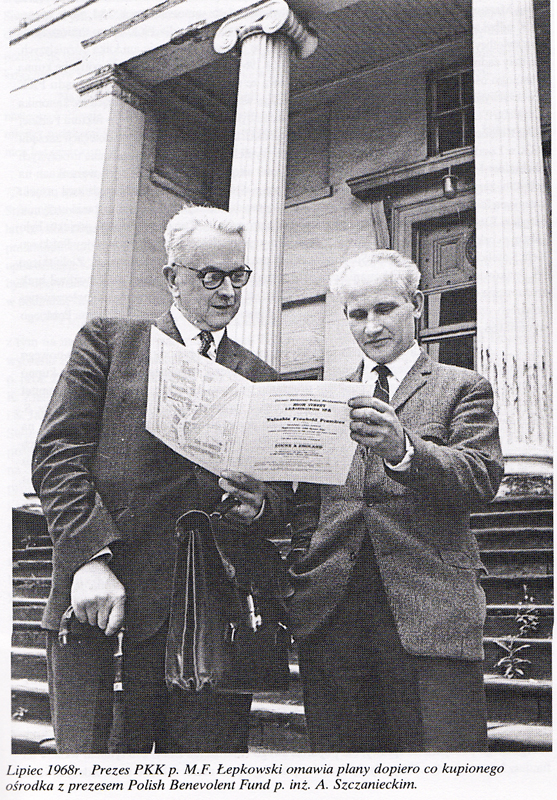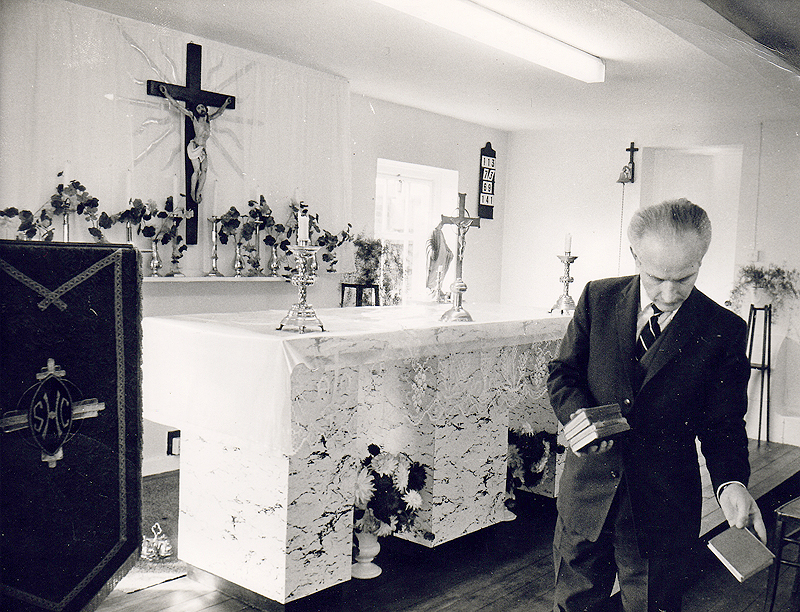Opening of The Polish Centre in 1969
THE FIRST YEAR
In the first year of its existence, thanks largely to labour provided by volunteers, the building was made fit for its new purpose, and the first commercial and social institutions were created. First came the Delicatessen, initially controlled by the Centre Management, but later by the "Zarzad" of the "Kolo". The delicatessen was opened on 15th December 1968, and its first manager was Zofia Scholtz. She was succeeded by Mieczyslaw Franciszek Lepkowski and Jozefa Siwak. Initial hopes that the venture would prove profitable, turned out to be misplaced, and on 30th March 1969 an extraordinary AGM debated the situation. From 21st September 1969 Aldona Zakrzewska helped in the Delicatessen, and after her resignation, Jozefa Siwak took over once more.
The chapel was also opened at this time. The altar was built and donated by Wincenty Sakowicz. The clubroom and bar were also rebuilt. M. Lisowiec built the bar for no charge, and in 1968 the first beer sales were made after mass. Officially, however, the Polish Catholic Club came into being at an extraordinary AGM on 24th December 1968, when the club constitution was adopted, and the first committee elected. It was decided that the club patron should be the parish priest, and the chair should be the chair of the "Kolo", whoever that might be. Stefan Wincenty Librowski was elected the first club secretary, and Stefan Kaszczyszyn the first treasurer. The remaining committee members were Bielawska, Jozefa Siwak, Krystyna Lepkowska, Waclaw Swienc, W. Kornel, S. Przedpelski and Prof Zbigniew Antoni Scholtz. The club constitution was adopted by being signed by all those present at the extraordinary AGM. The first dance at the club was held on 12th April 1969. The official opening came much later.
It would have been nice to mention all those who gave their labour freely at this early, and difficult time, enabling the refurbishment of the Centre to go ahead. This isn't possible, because those who were members of the various committees, regarded this as a moral duty, and their names are not mentioned in the minutes of meetings. Three people, who were not on any committee, were however given a vote of thanks: Jozefa Siwak, Jan Sielatycki and Wincenty Sakowicz.
THE OFFICIAL OPENING
 |
| Opening of the Polish Club, 15th November 1969 |
On 15th November 1969 the Polish Centre was officially opened by Bishop Szczepan Wesoly, and the club was opened by the Mayor, Alderman O. Robbins. At 3.45 a representative of the "Zarzad" met the Bishop and Monsignor W. Staniszewski at the railway station, and drove them to tea at Leokadia Tomaszewska's. At 4.00, the acting chair of the "Kolo", Waclaw Swienc, and the secretary Zofia Sawczyc, together with a girl dressed in national costume, greeted the Bishop and Monsignor W. Staniszewski with the traditional salt and bread.
The main event was a mass in the chapel, at which the children were confirmed. The Certificate of Blessing can still be seen in the "Zarzad" office. Concern was expressed about the strength of the floor in the chapel, so the congregation was limited to 170. Everyone else had to stand on the stairs and in the hallways, listening to the mass through loudspeakers.
At 5.45 the secular celabrations began with the Mayor, Alderman Robbins, cutting a ribbon at the entrance to the club. In a speech made on this occasion, the chair of the "Kolo Rodzicielskie" (Parents' Committee) spoke about the last time a Polish person had set foot in the building: Our present Centre is located in a historic building, the former Town Hall. The hall in which we are standing has surely seen many celebrations, events and tragedies. For us, what matters is that 130 years ago, in 1838, one of the guests invited here for the official reception in honour of Prince Louis Napoleon, the future Napoleon III, was his friend, a Polish patriot and freedom fighter, Colonel Kazimierz Oborski. He was a recipient of the highest Polish military honour, the Virtuti Militari, and a commander of the French Legion d'Honneur. He had commanded Napoleon Bonaparte's personal guard, the Krakusi, the 3rd Hussars at the time of the Duchy of Warsaw and the invasion of Russia, and had also fought in the November Uprising in Poland in 1830. He was a political émigré. After the Uprising, he settled in Leamington Spa, in a small house in Russell Street, where he died. He lies buried in the old New Street burial ground. While Louis Napoleon was in Leamington, Oborski was his constant companion.
Reports of this occasion featured in the Polish press, and in the local British press, and for once they were positive and accurate.




